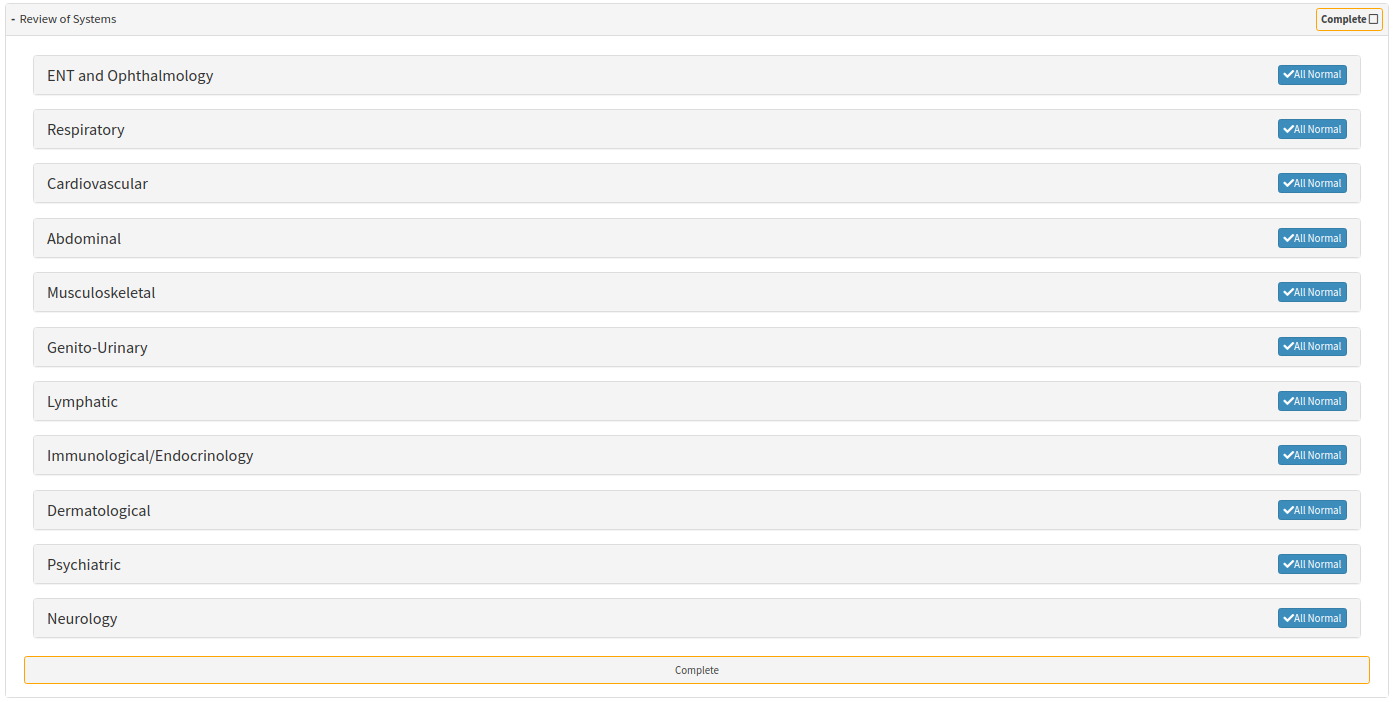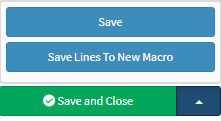How to Use the Psychiatric Subpanel
Psychiatry involves the study, diagnosis and treatment of mental illnesses. A Psychiatrist is a Practitioner that works with individuals that struggle with mental illness, and are able to give personalised treatment plans such as prescribing the necessary medications or leading the Patient through therapeutic discussions.
- The contents of this user manual will consist of the following information:
- ADD
- ADHD
- Anxiety
- Bipolar Disorder
- Depression
- OCD
- Substance Dependency
- General Notes
- This user manual will start on the General Examination form, Review of Systems panel.

- For more information regarding the General Examination form, please refer to the user manual: General Examination Overview.
- Click on the Review of Systems panel.
![]()
- The Review of Systems panel will expand.

- Click on the Psychiatric sub-panel.

- The Psychiatric sub-panel will expand.

ADD
Attention Deficit Disorder (ADD) is a diagnosis given to Patients who are characterised by inattentiveness, distractibility, and various other mannerisms.- Click on the ADD button once to indicate that the Patient has been consulted for ADD.

- The ADD button will turn green, which is an indication of normal results.

- Click on the ADD button a second time, which turns the button red. The red is an indication that results were logged within the button, and is not within normal range.

- Click on the General Notes text box to make any necessary notes. The General Notes field is a free text field.

Please Note: Click on the ADD button for a third time to deselect the button, and collapse all of the information found within.
ADHD
Attention Deficit Hyperactivity Disorder (ADHD) is a diagnosis given to Patients who are characterised by hyperactivity, forgetfulness, and various other mannerisms- Click on the ADHD button once to indicate that the Patient has been consulted for ADHD.

- The ADHD button will turn green, which is an indication of normal results.
- Click on the ADHD button a second time, which turns the button red. The red is an indication that results were logged within the button, and is not within normal range.

- Click in the General Notes text box to make any necessary notes. The General Notes field is a free text field.

Please Note: Click on the ADHD button for a third time to deselect the button, and collapse all of the information found within.
Anxiety
Anxiety is a normal emotion that arises in stressful situations, however, can become abnormal when a Patient has excessive amounts of Anxiety that affects their daily lives. Increased heart rate and blood pressure, as well as having a constant feeling of nervousness could be an indication of an Anxiety disorder that requires intervention.- Click on the Anxiety button once to indicate that the Patient has been consulted for Anxiety.

- The Anxiety button will turn green, which is an indication of normal results.

- Click on the Anxiety button a second time, which turns the button red. The red is an indication that results were logged within the button, and is not within normal range.

- Click in the General Notes text box to make any necessary notes. The General Notes field is a free text field.

- Please Note: Click on the Anxiety button for a third time to deselect the button, and collapse all of the information found within.
Bipolar Disorder
Bipolar Disorder is characterised by a Patient having manic and depressive episodes that consist of extreme emotional highs followed by intense emotional lows. Treatment and early intervention is important for leading a manageable lifestyle with Bipolar Disorder.- Click on the Bipolar Disorder button once to indicate that the Patient has been consulted for Bipolar Disorder.

- The Bipolar Disorder button will turn green, which is an indication of normal results.
- Click on the Bipolar Disorder button a second time, which turns the button red. The red is an indication that results were logged within the button, and is not within normal range.

- Click in the General Notes text box to make any necessary notes. The General Notes field is a free text field.

Depression
Prolonged feelings of intense emotional lows, coupled with strong negative thoughts, could be an indication of a Depressive disorder. A Practitioner could either suggest therapeutic intervention, or prescribe medication.- Click on the Depression button once to indicate that the Patient has been consulted for Depression.

- The Depression button will turn green, which is an indication of normal results.

- Click on the Depression button a second time, which turns the button red. The red is an indication that results were logged within the button, and is not within normal range.

- Click on the General Notes text box to make any necessary notes. The General Notes field is a free text field.

Please Note: Click on the Depression button for a third time to deselect the button, and collapse all of the information found within.
OCD
Obsessive-Compulsive Disorder (OCD) is a type of anxiety disorder characterised by excessive and repetitive behaviours that affect a Patient's everyday life.- Click on the OCD button once to indicate that the Patient has been consulted for OCD.

- The OCD button will turn green, which is an indication of normal results.
- Click on the OCD button a second time, which turns the button red. The red is an indication that results were logged within the button, and is not within normal range.

- Click on the General Notes text box to make any necessary notes. The General Notes field is a free text field.

Please Note: Click on the OCD button for a third time to deselect the button, and collapse all of the information found within.
Substance Dependency
When a Patient has an unhealthy reliance on harmful substances such as prescription medication, alcohol, etc., in order to function in their daily lives, a substance dependency has developed. Addiction can occur with items as simple as cigarettes, however, addictions can occur with illegal substances such as heroin, too.- Click on the Substance Dependency button once to indicate that the Patient has been consulted for Substance Dependency.

- The Substance Dependency button will turn green, which is an indication of normal results.
- Click on the Substance Dependency button a second time, which turns the button red. The red is an indication that results were logged within the button, and is not within normal range.

- Click on the General Notes text box to make any necessary notes. The General Notes field is a free text field.

Please Note: Click on the Substance Dependency button for a third time to deselect the button, and collapse all of the information found within.
General Notes
Any additional notes can be made within the General Notes button.- Click on the General Notes button once to turn the button green.

- The General Notes button will turn green, which is an indication that no changes were made.

- General Notes button a second time, which turns the button red. The red is an indication that results were logged within the button, and is not within normal range.

- Click in the General Notes text box to make any necessary notes. The General Notes field is a free text field.

Please Note: Click on the General Notes button for a third time to deselect the button, and collapse all of the information within.
- Click on the Close button to exit the Clinical Case screen without saving.
- Click on the drop-up menu next to Save and Close for more saving options.

- Save: The user is able to save the changes made to the form without closing the form.
- Save Lines To New Macro: Allows the user to create a New Macro.
- For an extensive explanation of the New Macro feature, please refer to the user manual: Macros (Billing Combinations).
- Click on Save and Close to save the General Examination form and close the screen to return to the main Diary screen.
![]()
Last modified: Thursday, 21 December 2023, 3:26 PM